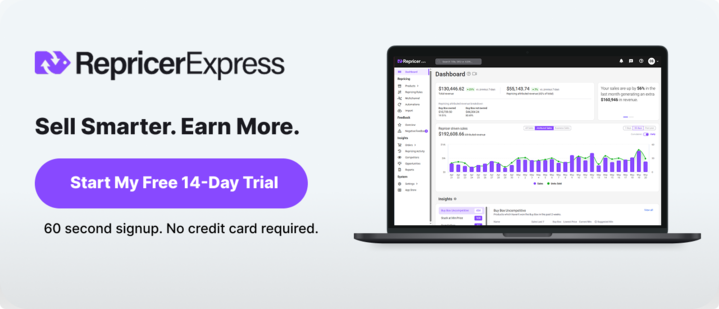How do you prepare for seasonal trends on Amazon and actually profit during peak shopping periods? In short, start by forecasting demand at the ASIN level, setting floors and ceilings in your pricing rules, and stress testing inventory, listings, and support before the rush. Once you hold the Buy Box, make small data-led lifts to find your ceiling so revenue grows without cutting into your margin.
In this guide, we’ll give you a clear play-by-play for demand signals, pricing guardrails, inventory plans, listing tweaks, and support workflows you can put to work this week.
What do peak shopping periods look like on Amazon?
Seasonal demand on Amazon follows a familiar rhythm.
You see early spikes from events like Prime Big Deal Days and category-specific promos, then a long climb into Cyber Week and late gifting. That wave repeats across back to school, spring refresh, and summer travel. But while the shape is stable, the size changes with price sensitivity, discount depth, and what your competitors do.
What does that mean for you? Seasonal trends on Amazon are large enough to shift your category overnight. If you plan price, stock, and service around those windows, you can catch demand rather than merely chasing it.
Cyber Week 2024 reached $314.9B in global online sales and $76B in the US.
How to spot seasonal trends on Amazon for your catalog
Forget a haul of fancy tools when you get started. All you need is a repeatable way to see patterns, and act on them.
Here are some ideas:
- Pull last year’s sales, price, and session data by ASIN for your core SKUs and look for two- to four-week surges around major retail moments.
- Because gifts, replenishable consumables, outdoor, electronics, and apparel each peak on different dates, tag SKUs by peak season type, then respond to different discount depths.
- Watch early lead indicators such as rising page views while conversion drifts down, which signals price-hunting and is your cue to review price competitiveness and Buy Box share.
- Track competitor posture by paying attention to who moves first on price in your subcategory and by how much, then map those patterns so you’re not surprised during the next surge.
- Decide your role by SKU so hero SKUs push volume with aggressive but safe rules, profit SKUs ride the wave with higher floors once you secure the Buy Box, and long-tail items stay protected.
And if you’re seeing slower retail growth, Amazon’s peak windows still hit, so the edge comes from better execution.
Smartphones drove 54.5% of online transactions during the 2024 holiday season.
Your peak week pricing playbook
Crucially, you don’t win a peak by dropping your prices everywhere. You can win by setting rules that respond to real signals and protect floor margins.
Here’s our advice:
- Set your floors correctly. Include landed cost, Amazon fees, shipping, and a minimum margin target by SKU. Then use repricing rules to respond within those limits so you never bleed below target. Link rules to velocity or Buy Box position rather than emotion. (Pro tip: tune your repricing rules to react quickly while protecting profit.)
- To win more Buy Box share, chase, then lift. When you hold the Buy Box and conversion holds steady, increase the price in small steps to find your ceiling. If your offer remains featured, keep lifting until conversion starts to dip.
- Use event-specific rules and build temporary rulesets for Prime events, category events, and Cyber Week. Set tighter min and max, faster reaction time, and explicit guardrails for out-of-stock scenarios.
- FBA offers often tolerate slightly higher prices once shipping speed qualifies for Prime, while FBM needs sharper pricing or faster service level to compete. So, separate FBA from FBM logic.
- Avoid whiplash by limiting the number of price moves per hour on sensitive SKUs. The goal is competitive stability that looks trustworthy to buyers and to Amazon’s Featured Offer algorithm.
Also, your pricing rules should support a seamless checkout experience. If your price bumps or shipping terms surprise buyers late in the process, they’re far more likely to bail.
Cyber Monday 2024 hit $13.3B in online spend, up 7.3% year over year.
Prevent stockouts with these checks
Seasonal trends on Amazon are brutal if your best sellers run dry.
This is our headache-saving checklist:
- Forecast FBA and FBM separately. Add a cushion to lead times because FBA cutoffs move in peak and inbound receiving can slow.
- Keep a safety buffer on your best sellers. Aim for about one extra week of stock to protect margin.
- Split fulfilment risk. Send most units to FBA for Prime speed, and keep a small FBM reserve so you can keep selling if FBA tightens.
- Clean up your catalogue. Remove duplicate listings and fix variation mismatches so you don’t create phantom stock during spikes.
- Track carrier performance. Watch for peak surcharges and delays, adjust handling time, and set realistic delivery windows to avoid negative feedback.
Online holiday retail sales rose 6.7% while in-store increased 2.9% from Nov 1 to Dec 24, 2024.
Easy wins for better conversion
Small fixes compound when traffic surges, so don’t overlook these small-but-mighty actions:
- Refresh images and copy by leading with outcome-focused imagery, adding at least one lifestyle photo, and including a clear size or fit cue where it matters.
- Tighten titles and bullets so they highlight the top three reasons to buy that shoppers actually search for.
- Streamline variations so buyers can find the right color or size quickly instead of backing out.
- Add returns clarity with clear, fair policies that build confidence during gifting.
- Tune price presentation so coupons or strikethroughs make savings obvious without asking shoppers to do the math.
Make sure your images and A+ content read well on a phone screen. Seasonal trends on Amazon are increasingly mobile-first.
Mobile drove the majority of online transactions during Holiday 2024, at 54.5% of orders.
Automations that save time during peak trading
You don’t need to automate everything to feel the benefit, so focus on the repetitive stuff so your team can handle the hard stuff.
- Auto tag by intent by sending “where’s my order” threads to a shipping queue, product questions to presales, and returns to a single path with clear next steps.
- Suggest reply drafts by using AI to prepare first responses that include tracking, return windows, and any exceptions, then let agents approve and personalize.
- Schedule price events by preloading your peak rulesets so price changes go live when traffic goes live.
- Set multichannel guardrails by keeping marketplace and webstore prices aligned to avoid channel conflict and price gap screenshots, and if you sell beyond Amazon keep prices aligned so shoppers see a consistent story.
The final five days before Christmas accounted for 10% of all holiday spending in 2024.
Main takeaways and what to do next
Three big takeaways:
- Seasonal trends on Amazon are predictable enough to plan for, if you look at last year’s demand by ASIN.
- Smart pricing with floors and event rules beats blanket discounts.
- The fastest way to lose margin is through stockouts and messy listings when traffic spikes.
Three moves to make this week:
- Pick five SKUs, plot last year’s weekly sales, set floors, and create a simple peak ruleset that lifts price once you hold the Buy Box.
- Add one mobile-friendly image and a clear size or fit cue to your best seller listing, then sanity-check titles and bullets.
- Draft two support templates that pull tracking into replies and set expectations for delivery during peak weeks.
Want to protect margin, react to seasonal trends on Amazon in real time, and keep prices and service tight when traffic surges? Book a free demo and we’ll show you how to set rules, hold the Buy Box, and automate the busywork while staying in control.
FAQs
What are the biggest peak shopping periods on Amazon?
Most sellers see spikes around Prime events, back to school, and Holiday, with the steepest lift during the Cyber Five. Seasonal trends on Amazon also show mini peaks in spring and early summer, depending on category.
How often should I adjust prices during a peak?
Enough to stay competitive, but without creating whiplash. Use rules that react to Buy Box status and competitor changes, then lift price carefully once you’re featured. A structured approach with repricing rules is safer than manual edits.
Should I keep raising the price if I hold the Buy Box?
Yes, within your guardrails. Lift in small steps and watch conversion. If conversion holds and you stay featured, keep exploring your ceiling. If it dips, step back.
What’s the most common mistake during peak?
For many sellers, it’s running out of your hero SKUs. So make sure you model FBA and FBM separately, hold a small reserve for surge days, and reconcile SKUs and variations before traffic hits. The cost of out-of-stocks is huge at peak scale.
Do seasonal trends on Amazon matter if overall retail growth is slow?
They matter more. When budgets are tight, shoppers hunt for value in short windows. If your listings, price, and service are ready, you can win share from competitors who are slow to react.



